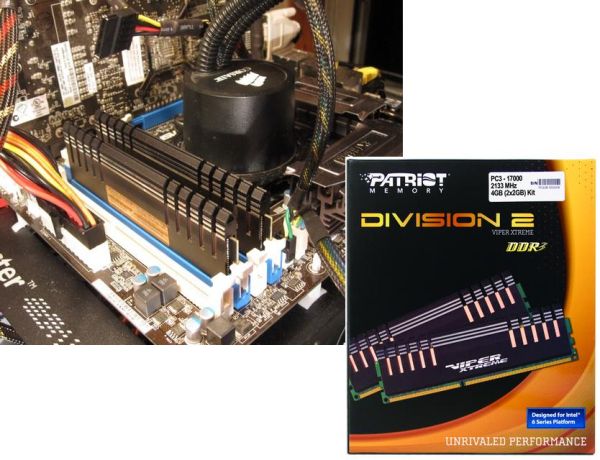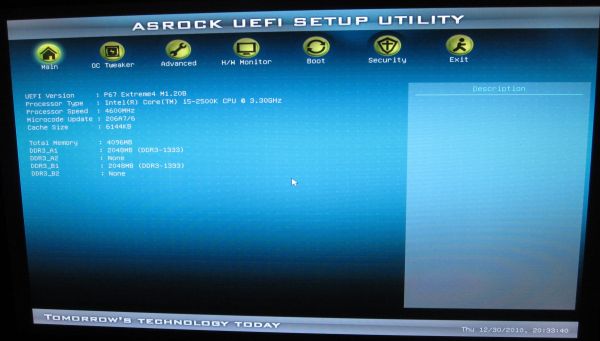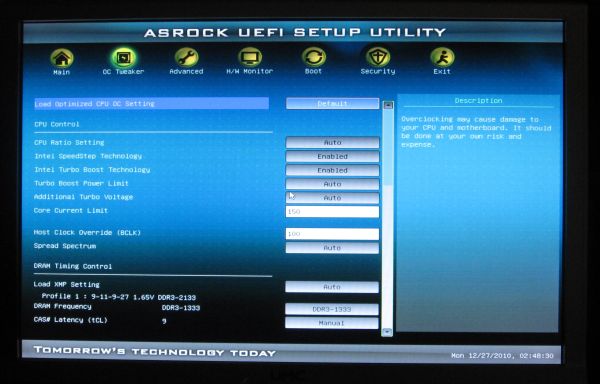Welcome to Sandy Bridge, with the ASRock P67 Extreme4
by Ian Cutress on January 3, 2011 7:00 AM EST- Posted in
- Motherboards
- ASRock
Test Setup
| Processor |
Intel i5-2500K ES—3.3GHz (3.7GHz Turbo) 4 Cores, 4 Threads, 6MB L3 |
| Motherboards | ASRock P67 Extreme4 |
| Cooling | Corsair H50-1 Water Cooler |
| Power Supply | Enermax Modu87+ 600W 80PLUS |
| Memory |
Patriot Viper Xtreme DDR3-2000 9-10-9-27 2x4GB Kit, 1.65V Patriot Viper Xtreme Division 2 DDR3-2133 9-11-9-27 2x2GB Kit, 1.65V |
| Memory Settings | Patriot Viper Xtreme Division 2 2x2GB @ DDR3-1333 9-9-9-27 |
| Video Cards | XFX HD 5850 1GB |
| Video Drivers | Catalyst 10.12 |
| Hard Drive | Intel X25-M 80GB SSD Gen2 |
| Optical Drives | LG GH22NS50 |
| Case | Open Test Bed—CoolerMaster Lab V1.0 |
| Operating System | Windows 7 64-bit |
| USB 2/3 Testing | Patriot 64GB SuperSonic USB 3.0 |
Each motherboard received a fresh operating system install before testing and benchmarking. For multi-GPU comparisons, dual XFX HD5850 GPUs at stock clocks were used with Catalyst 10.12 drivers. Memory is set at DDR3-1333 C9 to allow comparison to future H67/H61 motherboards.
Many thanks to Patriot Memory for sending their Viper Xtreme DDR3 kits to use in reviews. The 2x4GB kit, specifically for dual-channel operation, is rated at 2000MHz, CAS 9-10-9-27 at 1.65V and retails for $175. The 2x2GB Division 2 kit, also for dual-channel, is a newly released part by Patriot, specifically for P67, and runs at 2133MHz, CAS 9 11-9-27 at 1.65V. I am informed that this kit will retail for around $100.
Another comparison point for this review is an X58, socket 1366 system, based on the ASRock Extreme3 board that I reviewed in 2010. Quite a lot of people will have invested in an X58 system over the past twelve months, in the pursuit of performance, and it will be interesting to see how the stock i7-920 processor, and the P67 systems with the i5-2500K processor, compares.
| Test Setup | ||
| Processor |
Intel i7-920 d0—2.67GHz (2.93GHz Turbo) 4 Cores, 8 Threads, 8MB L3 |
|
| Motherboards | ASRock X58 Extreme3 | |
| Cooling | Akasa Nero | |
| Power Supply | Enermax Modu87+ 600W 80PLUS | |
| Memory | Corsair Vengeance DDR3-1600 9-9-9-24 3x4GB Kit, 1.50V | |
| Memory Settings | Corsair Vengeance DDR3-1333 9-9-9-24 3x4GB | |
| Video Cards | XFX HD 5850 1GB | |
| Video Drivers | Catalyst 10.12 | |
| Hard Drive | Samsung PB22-J SSD 60GB | |
| Optical Drives | LG GH22NS50 | |
| Case | Open Test Bed—CoolerMaster Lab V1.0 | |
| Operating System | Windows 7 64-bit | |
The results for other P67 motherboards are included also in this review to provide points for comparison. Full reviews for these boards will be published shortly. A note on the Gigabyte P67A-UD4 board - the latest BIOS at time of writing (F5) seems to have issues with its Turbo mode, resulting in a 1x multiplier increase rather than the expected 4x when one core is active. As such, results from the UD4 in single threaded benchmarks may be lower than expected. These results will be updated if the BIOS is fixed by the time that review is published. Update: The F7 Beta BIOS for the UD4 implements turbo correctly - the graphs have been updated.
UEFI
One of the main features of the Sandy Bridge platform is the new BIOS interface, the Unified Extensible Firmware Interface (UEFI). Almost everything about the UEFI is similar to the BIOS system of old—the menus and the options are identical. The only difference is the GUI—we now get colors and images (which I can see getting more elaborate as the system grows in time), and the use of the mouse. Each vendor's UEFI implementation will be visually quite different, if they've implemented it at all.
Initially, you will find that in the Extreme4 UEFI, the mouse wheel does not work. This is not a massive deal-breaker, by any means. I still prefer using the keyboard to navigate all the options, and I had no issues in using the arrow keys. You can’t use the number pad to put in voltages and such, which would be a nice touch.
The main menu option of choice is the optimized CPU OC setting. In general, it is best not to trust this option on any motherboard, but ASRock have done a good job here. It offers auto-overclocking settings from 4.0GHz to 4.8GHz in 0.2GHz steps, which as I’ll talk about below, the 4.6GHz setting is the preferential setting for our 24/7 overclock.
The CPU multiplier and BCLK are fully adjustable. The memory timings are linked for every memory stick in the board—as this isn’t the highest end board, we didn’t expect the ability to set every channel independently. The board also allows saving up to three profiles, and OC recovery worked when we overclocked to 5GHz while setting a low voltage.
One thing of note is that the ASRock UEFI version 1.20B sets the BLCK over the 100MHz standard. ASRock have set this at 100.4MHz (even though this isn’t visible in the UEFI, only in the OS), meaning that they hope to gain a 0.4MHz BCLK advantage over other manufacturers at stock speed. We experienced no instability due to this, so we will see how this affects the results against other motherboards.
As a first go, the ASRock UEFI interface isn't radically different, but it works well. We're more interested in seeing the UEFI system enhancements over the coming months! It opens up a lot of new options if anyone puts the necessary effort into it, so we could see some very cool additions down the road.



















55 Comments
View All Comments
chrnochime - Monday, January 3, 2011 - link
So basically for any CPU that has its multiplier locked, there's just no way to oc the CPU. Either pay up for an unlocked CPU or be content with stock speed. Hmm...wolfman3k5 - Monday, January 3, 2011 - link
I've read all the Sandy Bridge articles that you guys posted. And while at first glance it seems that you're really enthusiastic about the products, they are low end and mid range products. What I take from all the Sandy Bridge articles is that X58 high end platform is obsolete and that everyone should jump on the mediocre Sandy Bridge bandwagon. When I'm saying mediocre I'm not referring to the Core i5 2500K or to the Core i7 2600K CPUs. I'm referring to the rest of the platform and its limitations. No full support for SATA 6.0 (which AMD already had for months), only two 8X PCI-E lanes for high end SLI or CrossFire configurations, only dual channel memory. I mean, it is obvious that this is a new product and that Intel needs to sell it, but it doesn't mean that everyone who got a high end system on a X58 platform should throw it away. Also, the old X58 platform is far more modular. Yes, I know that X58 is old, and I hope that we'll see an update in the high end segment.But the question is: Do you guys ever get tired of advertising for Intel, or is the money just too good?
extide - Monday, January 3, 2011 - link
If you actually read all the articles like you said, you would see that they said that if you already have a high end x58/i7 system, then you should keep it. If you are considering BUYING a new system then they suggest getting SB over a p55 or x58 system.wolfman3k5 - Monday, January 3, 2011 - link
X58 has been around before LGA1156, and is still around. Sandy Bridge is meant to kill everything that runs on LGA1156, not X58. The platform that Sandy Bridge runs on will be obsolete in 6 months. PCI-E 3.0 is just around the corner. That's when LGA2011 will be released, the successor of LGA1366. Conclusion: It doesn't really matter if you buy X58/i7 or P67/SandyBridge, they'll be both obsolete.AssBall - Monday, January 3, 2011 - link
So you must never buy anything new, because in 6 months it will be obsolete. Just because there are new platforms doesn't mean the old ones are useless or no longer cost effective.I don't see where you get that "advertising for intel" junk from, either.
vol7ron - Monday, January 3, 2011 - link
Wolfman, if you read any of Anandtech's articles, you'd know they don't accept compensation for any of their reviews - while this has helped them out sometimes, it has also hurt them. They have to be careful to be non-biased, but also respectful of manufacturers. Downing a product too much means they won't get as many products to test in the future (and have to wait longer to buy it for the review), not being honest enough discredits the article in the reader's eyes - the fine line must be walked and words chosen delicately. Still, funding is from advertisement and donations.Your AMD points are valid, but still unimpressive in comparison. As they stated, AMD is a better option for the lower CPUs, since you can OC them, whereas Intel has locked the i3's.
I agree, USB3 needs adoption, they've had long enough. That said, Intel is still in domination and AMD has some work to do if they want to contend.
DanNeely - Monday, January 3, 2011 - link
The point of the reviews is that unless you need something that is only available on x58 (ie enough PCIe lanes for 3/4GPU setups, or 2 GPUs and a high end raid card) then there's next to no point in buying into the platform because a $300 2600k, is able to beat a $1000 hexcore in most benchmarks.I'm interested in LGA2011 too because a 30% faster quad core isn't overly exciting as an upgrade. My main concern is that with the 2600K running $300, that intel might demand $500+ for a hexcore that doesn't have crippled OC limits.
Etern205 - Monday, January 3, 2011 - link
The only people interested in PCIe 3.0 are the gamers and enthusiast. 99% of the average use won't give a thought about what they have and test shows PCIe 2.0 doesn't have that much of a improvement over PCIe 1.1 in terms of performance.LGA 2011 the successor to LGA 1366 is still call Sandy Bridge. Funny how your not interested in this "obsolete" hardware but excited about the one after which by your terms is still "obsolete". This is the first time I've seen a person excited about some outdated hardware which has yet gone out the door.
As for AMD, if they made a CPU that can out perform Intel, I'm sure this site and all other will be all over it like a celebrity meet with lights and flashes. Unfortunately, the last time AMD has that spot light was before Intel came up with the Conroe.
Hopefully, AMD's bulldozer will let them once again shine in the spot light.
tim851 - Tuesday, January 4, 2011 - link
99% of the average users are still happy with the Athlon X2s they bought in 2005...mapesdhs - Wednesday, January 5, 2011 - link
That's a good summary, unless of course one prefers to dabble with 'traditional'
overclocking and/or overall platform costs of P55/X58 are more attractive. There
are plenty of very well priced P55 boards available now. Hard to give a concrete
nod to SB without knowing the mbd costs.
Personally, my results reinforce your summary. Performance-wise, SB offers
nothing useful over what I already have. Different though perhaps for someone
who is running with an i3/i5 on a P55 board, but yet again it depends on the
application.
Ian.
PS. I've praising Asrock's PCIE slot spacing for months, very glad to see
they're sticking to it. Their P55 boards use the same setup. Perfect for
cooling SLI/CF setups and a lot better than most X58 boards.